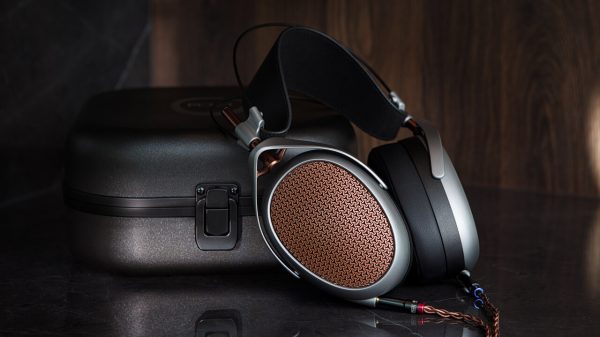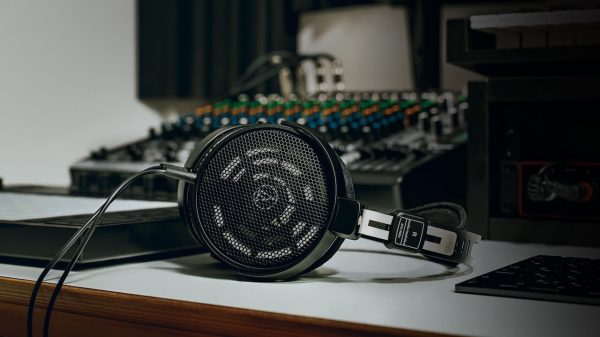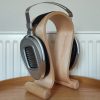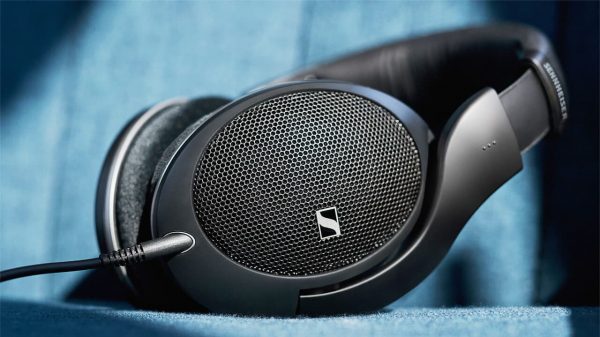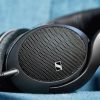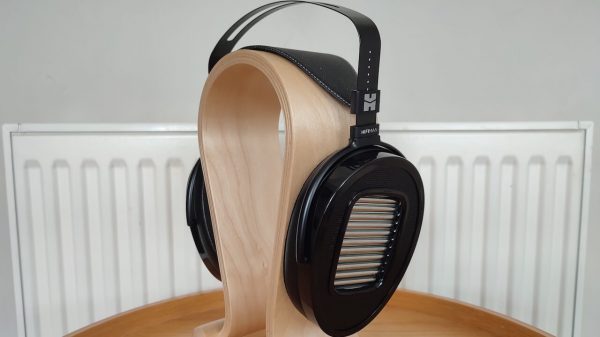STAX has been making electrostatic headphones since 1938 and the Lambda series since 1988. I’ve tried various STAX systems over the years and more often than not came away impressed and wondering if I should start playing the lottery numbers on a regular basis.
STAX products have always been known in the market as top-shelf audio, and the prices tags have reflected that as the least expensive models still command about $1,500 USD by the time you purchase a headphone and an energizer.
Move to the top end of the line, and you can spend $12,000 and you’ll still need to bring your own DAC as the SRM-T8000 energizer is strictly an amplifier.
For most listeners, that puts STAX out of reach, but for dedicated audiophiles, the market has changed over the past few years and where STAX used to stand as the sole headphone you could purchase over $1,000, today it is common to find flagship headphones over $5,000 from a growing list of manufacturers.
So, that begs the question, what would happen if I took the money I would have spent for a flagship headphone elsewhere and instead took that money to STAX and bought an electrostatic headphone system?

STAX was kind enough to provide a SRM-D10 MK2 energizer ($945) and an SR-L700 MK2 headphone ($1,649) for audition. Hardly chump change, but take that same amount shopping at Dan Clark, Audeze, Focal, or Meze and see how far it goes today.
You won’t come home with any of their flagship headphones, nor do they come with a DAC/Amp. For those that would rather have a desktop unit than the little portable D10 energizer, the 353x energizer comes in at almost exactly the same price so the argument still applies whether looking at a portable or a more sedentary system.
But can the STAX pairing compete with flagships from other makers? Are they good value compared to models like the LCD-5, Stealth, Empyrean, or Utopia?
We reviewed the SRM-D10 MK2 here along with the SR-003 MK2 “Baby STAX” in-ears, so this review will focus on the SR-L700 MK2 (aka MKII or MK II) headphones.

The L700 MK2 are the pinnacle of the Lambda series models that began all those years ago and still look, feel, and sound quite similar. Changes to the L700 have improved the headband, made it easier to replace pads, and added a detachable cable, but it is otherwise largely unchanged.
The drivers are rectangular so the cups (if they can be called that) look a bit different which is likely why you hear the STAX models in general and the Lambda series specifically referred to as ear-speakers.
They look a bit like typical speaker boxes in shape and because of the large grill protecting the rear face of the driver. They are deceptively light for a headphone this large with a total weight of just 372 grams and the suspension headband does a great job of distributing that weight making them easy to wear.
The compromise here is to keep the weight in check; there is a good bit of plastic in the build and these are likely more breakable than some heavier models so some care is advisable.
The earpads are lambskin and even with glasses on, were quite comfortable for extended listening sessions (something I cannot say for some of the heavier flagships).
The L700 MK2 is an open back design so expect everything you hear as the listener to be audible to anyone else in the immediate vicinity.

The cable is a flat ribbon using silver coated 6N copper and my only gripe is that a shorter version is not readily available. The stock cable is over 8 feet long and when paired with a portable amp makes it more cumbersome to move about with the pair.
There is not an issue when seated and the cable had no issues with microphonics, so my gripe is more about use case than any issue with the cable itself. My only other gripe is there is no case provided and with the need to protect the drivers from dust, moisture, and pet hair, it is definitely odd that one is not provided.
Looking at the driver specs is the first tip-off that something here is a bit different from your average headphone. The Impedance of 145k ohms is one hint, while the sensitivity measured at 100V is the other.
The drivers are electrostatic meaning that instead of magnets like those typically used in planar and dynamic drivers, these use a bias charge and an electric field. Two electrical grids (Stators) sit on either side of the thin-film diaphragm which is charged using a bias charge so it has a net positive charge.
Unlike most other technologies, the audio signal is not passed to the diaphragm, but instead to the stators. As a result, the positively charged diaphragm moves in proportion to the size and charge of the signal on the stators, thus producing sound waves.
This explains the need for an energizer that is different from the amplifiers used with other headphones as in addition to amplifying the audio signal, an electrostatic energizer has to send the appropriate bias charge to the diaphragm.
Most STAX headphones use 580V bias although some older models use a lower charge. This is of course an over-simplification for sake of brevity so if you are interested, be sure to read more on STAX website.
Because the diaphragm moves in direct response to the audio signal, rather than the audio signal being a degree removed like it is in some other systems, electrostatic headphones are typically faster and can have better transient response.
The result is that electrostatics generally sound more effortless in their delivery and cleaner, but the downside can be that they sometimes struggle to produce big bass due to the limits of the drivers. Remember bass is a function of size and distance travelled and while electrostatic drivers are often large, they travel very small distances compared to the movement of a dynamic drivers cone.

Listening notes
On the low end, I expected the L700 MK2 to sound like the SR-007 and SR-009 that I’ve heard recently; clinical, tight, extremely well textured, but a touch dry.
I was completely wrong.
The L700 MK2 is a bit warmer and not quite as clinical and compared to the 007 that I had on hand, and maybe even a bit loose. No, not booming mud with no detail, but compared to the gold standard these don’t offer bass notes with as much control or impact.
That’s not a bad thing as they are actually more enjoyable as a result; they have a little less sub-bass presence but a bit of a mid-bass elevation that gives them a warm tone without sacrificing quality.
Comparing the L700 MK2 to competitors like the Sennheiser HD 800 S and Focal Utopia shows that even a “loose” STAX is better defined and textured than a top-end dynamic driver so it’s hard to quantify them as anything other than slightly subdued in the sub-bass range and with more emphasis in the mid-bass.
There is a distinct focus on the midrange with the L700 MK2, which will appeal to those who prefer that approach, but those that prefer a more balanced overall tonal balance and presentation might feel that the midrange is too much of the show; some might misinterpret that as “forward” sounding and that would not be correct.
There is a level of transparency to the sound in the midrange that will catch your attention almost immediately.
Vocals cut through the instrumentation well with both male and female vocals having an even footing rather than one being decidedly in front or behind the other.
The L700 MK2 is particularly impressive with Acapella groups as the vocals are just about perfect with good weight and ample texture. Strings are also very well rendered with enough body and detail to sound quite realistic.
The upper midrange and lower treble are presented with enough energy to remaining engaging, without becoming fatiguing with most music.
Having said that, lower treble is light and airy without being overly forward and takes a step back from the midrange in the overall signature.
There isn’t a ton of sparkle here but it doesn’t sound closed in either and there is plenty of detail without being bright. Percussion snap is very good with sharp edges on snare rattle and good cymbals again whilst still sounding somewhat reserved and relaxed in its voicing.
Unlike the 007 and 009 models, the L700 MK2 proved to be an easy and comfortable listen during longer sessions.
Overall, there is a small dip in sub-bass, a minor lift in mid-bass and a focus on the midrange with a polite but very detailed treble.
The L700 MK2’s soundstage was a bit of a surprise as the other STAX models have good stage dimensions but I would not say they are big stages; just extremely well proportioned and precise so they sound larger than they are.
The L700 MK2 has an extremely wide stage with good depth and height to go with it, but it is not equal in width and depth. The result is a presentation that at times sounds wider than deep and is very distinct when compared to the 007 or even the 009 models.
Instrument separation is extremely good and layering is as well, so seating the orchestra yields no gaps or overlaps. Binaural recordings really show off the soundstage dimensions.

Comparisons
If I had spent $2,600 at Audeze, I could have brought home either an LCD-3 or MM-500 as the LCD-MX4 runs $2,995 and doesn’t quite make our price cut-off. Shopping at Dan Clark Audio would net the Ether 2. Focal is less of a fit as the Clear or Clear MG at $1,500 are the closest fit under our budget constraint.
Meze Audio’s $999 109 Pro Primal is the top model beneath our cap and it hardly seems fair to compare something at less than 50% of the price of the L700 MK2, so I’m going to stick with the Ether 2 and the MM-500 as the two most relevant comparisons.
The Dan Clark Audio Ether 2 is a planar magnetic headphone using a 71mm x 45mm driver so while the cups are round on the Ether 2, the drivers share a common shape.
Build Quality certainly favors the Ether 2 as it is almost all titanium, aluminum, and carbon fiber compared to the largely plastic build of the L700 Mk2.
Sonic signatures when paired with a good system (I used my RME ADI-2 FS R BE DAC and the Pass Labs HP-1 amplifier with the Ether 2 for this compare) are similar as both are warm headphones in a way that surprises the listener as neither is a typical signature for the class of drivers.
The sub-bass is a bit more pronounced on the Ether 2 while the midrange is more forward sounding on the L700 MK2. The L700 MK2 is a bit better on vocals as the Ether 2 pushes female vocals slightly forward of the male vocals in the mix.
I couldn’t help but think that the midrange is a bit more detailed on the L700 MK2, but this may be subjective as they are definitely more highlighted on the L700 MK2 and the Ether 2 is by no means poor in this regard, it simply doesn’t accentuate the range as well.
Both have forgiving trebles with great detail so it’s hard to pick between the two.
I came away from this comparison thinking that I can get the same sonic signature and own the headphone and Energizer from STAX for roughly the same price as just the headphone from Dan Clark Audio. To my mind, that is high praise for the STAX.
I figured the Audeze MM-500 would be a tough task for the STAX even with it having a price $800 less than the STAX combo. I said it in the MM-500 review, I think this is the best Audeze headphone to date for price/performance as it comes closer to the flagships than it should for something that is less than 50 percent of the price and its arguably built better.
No, it doesn’t look as polished as the LCD series, but the solid aluminum chassis is definitely a step above the plastic in the L700 MK2. The MM-500 uses a 90mm planar driver so cup size is roughly comparable.
Weight is a bit heavier at 495 grams so those concerned about that will certainly prefer the STAX.
The Audeze’s build quality is definitely superior; more robust, durable when it comes to abuse, and with tighter tolerances.
Sonically, the two are quite different as the MM-500 is nearly neutral while the L700 MK2 is considerably warmer. Both have similar sub-bass quantity, but the edge goes to the MM-500 here, but once into the mid-bass the battle evens out and it will come down to personal preference.
Both have strong midrange performance and its hard to say anything to detract from either, but the L700 MK2 does seem to deliver the range a bit more fluidly and effortlessly so I have to give it a very slight edge.
The treble flips the script as the MM-500 is a bit more open and has more sparkle compared to a slightly more polite treble on the L700 MK2.
Depending on genre, mood, and preference either can leapfrog the other for the top spot. The L700 MK2 proved to be a strong performer against the MM-500 which Audeze markets as their “best monitoring” headphone.

Conclusions:
I think most will agree that electrostatic headphones have long been recognized as perhaps the most accurate sound reproduction of any headphone type. The drawbacks have been the need for special hardware to provide the needed bias to the diaphragm, the need to handle and store them more carefully than some other types, and the cost.
Two of those three issues have not changed, but arguably the third has changed. The market will pay a lot more for flagship headphones than it would just a few years ago when many thought $1k was the realistic limit of what anyone would pay for a headphone.
With more and more people purchasing headphones in the $2,500 price range, it made sense to research how the STAX L700 MK2 fits into that picture and whether buyers are making a mistake not looking at electrostatic headphones based on outdated attitudes.
I came away really impressed with what the L700 MK2 delivered for the price, even with the cost of the energizer included, it is half the price of most flagship headphones today and within striking distance of all of them where detail and speed are concerned.
The sonic signature is always going to come down to personal preference so it’s hard to pick a winner in that respect, but I found myself listening to the L700 Mk2 when I didn’t have to which speaks volumes since I have my choice of some of the best headphones currently available in my personal collection.
The L700 MK2 is a great listen as it is fluid, effortless, and musical while still being insanely resolving at the same time.
Consider this too, I used the most basic energizer STAX offers while doing my comparisons against a DAC and AMP for the planars that cost more than the STAX package as well.
There is room to improve on the L700 MK2 by going to a better DAC and a higher end energizer, while the planars were likely very close to their best performance.
If you are shopping for a headphone in this price range, first count your blessings as it’s still more than most will ever be able to spend on this hobby, then audition a pair of STAX SR-L700 MK2.
When I listened to my first pair of electrostatic headphones almost 40 years ago, I felt that they offered something very special that other headphones could not. After my experience with the SR-L700 MK2, that opinion still holds very true.
Where to buy:
- $1,649 at staxheadphones.com (SR-L700 MK2)
- $945 at staxheadphones.com (SRM-D10 MK2 energizer)
Related Reading:














